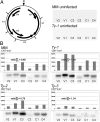Tomato yellow leaf curl virus resistance by Ty-1 involves increased cytosine methylation of viral genomes and is compromised by cucumber mosaic virus infection
- PMID: 25136118
- PMCID: PMC4156758
- DOI: 10.1073/pnas.1400894111
Tomato yellow leaf curl virus resistance by Ty-1 involves increased cytosine methylation of viral genomes and is compromised by cucumber mosaic virus infection
Abstract
Tomato yellow leaf curl virus (TYLCV) and related begomoviruses are a major threat to tomato production worldwide and, to protect against these viruses, resistance genes from different wild tomato species are introgressed. Recently, the Ty-1 resistance gene was identified, shown to code for an RNA-dependent RNA polymerase and to be allelic with Ty-3. Here we show that upon TYLCV challenging of resistant lines carrying Ty-1 or Ty-3, low virus titers were detected concomitant with the production of relatively high levels of siRNAs whereas, in contrast, susceptible tomato Moneymaker (MM) revealed higher virus titers but lower amounts of siRNAs. Comparative analysis of the spatial genomic siRNA distribution showed a consistent and subtle enrichment for siRNAs derived from the V1 and C3 genes in Ty-1 and Ty-3. In plants containing Ty-2 resistance the virus was hardly detectable, but the siRNA profile resembled the one observed in TYLCV-challenged susceptible tomato (MM). Furthermore, a relative hypermethylation of the TYLCV V1 promoter region was observed in genomic DNA collected from Ty-1 compared with that from (MM). The resistance conferred by Ty-1 was also effective against the bipartite tomato severe rugose begomovirus, where a similar genome hypermethylation of the V1 promoter region was discerned. However, a mixed infection of TYLCV with cucumber mosaic virus compromised the resistance. The results indicate that Ty-1 confers resistance to geminiviruses by increasing cytosine methylation of viral genomes, suggestive of enhanced transcriptional gene silencing. The mechanism of resistance and its durability toward geminiviruses under natural field conditions is discussed.
Keywords: RNAi; Solanaceae.
Conflict of interest statement
The authors declare no conflict of interest.
Figures




Similar articles
-
The Tomato Yellow Leaf Curl Virus resistance genes Ty-1 and Ty-3 are allelic and code for DFDGD-class RNA-dependent RNA polymerases.PLoS Genet. 2013 Mar;9(3):e1003399. doi: 10.1371/journal.pgen.1003399. Epub 2013 Mar 28. PLoS Genet. 2013. PMID: 23555305 Free PMC article.
-
Accumulation and transmission of alphasatellite, betasatellite and tomato yellow leaf curl virus in susceptible and Ty-1-resistant tomato plants.Virus Res. 2018 Jul 15;253:124-134. doi: 10.1016/j.virusres.2018.06.003. Epub 2018 Jun 15. Virus Res. 2018. PMID: 29908896
-
Ty-1, a universal resistance gene against geminiviruses that is compromised by co-replication of a betasatellite.Mol Plant Pathol. 2020 Feb;21(2):160-172. doi: 10.1111/mpp.12885. Epub 2019 Nov 22. Mol Plant Pathol. 2020. PMID: 31756021 Free PMC article.
-
The Global Dimension of Tomato Yellow Leaf Curl Disease: Current Status and Breeding Perspectives.Microorganisms. 2021 Apr 1;9(4):740. doi: 10.3390/microorganisms9040740. Microorganisms. 2021. PMID: 33916319 Free PMC article. Review.
-
Discovering host genes involved in the infection by the Tomato Yellow Leaf Curl Virus complex and in the establishment of resistance to the virus using Tobacco Rattle Virus-based post transcriptional gene silencing.Viruses. 2013 Mar 22;5(3):998-1022. doi: 10.3390/v5030998. Viruses. 2013. PMID: 23524390 Free PMC article. Review.
Cited by
-
Identification of Tomato Proteins That Interact With Replication Initiator Protein (Rep) of the Geminivirus TYLCV.Front Plant Sci. 2020 Jul 15;11:1069. doi: 10.3389/fpls.2020.01069. eCollection 2020. Front Plant Sci. 2020. PMID: 32760417 Free PMC article.
-
A nuclear-replicating viroid antagonizes infectivity and accumulation of a geminivirus by upregulating methylation-related genes and inducing hypermethylation of viral DNA.Sci Rep. 2016 Oct 14;6:35101. doi: 10.1038/srep35101. Sci Rep. 2016. PMID: 27739453 Free PMC article.
-
Soybean antiviral immunity conferred by dsRNase targets the viral replication complex.Nat Commun. 2019 Sep 27;10(1):4033. doi: 10.1038/s41467-019-12052-5. Nat Commun. 2019. PMID: 31562302 Free PMC article.
-
RNA Interference: A Natural Immune System of Plants to Counteract Biotic Stressors.Cells. 2019 Jan 10;8(1):38. doi: 10.3390/cells8010038. Cells. 2019. PMID: 30634662 Free PMC article. Review.
-
Solanum lycopersicum, a Model Plant for the Studies in Developmental Biology, Stress Biology and Food Science.Foods. 2022 Aug 10;11(16):2402. doi: 10.3390/foods11162402. Foods. 2022. PMID: 36010400 Free PMC article. Review.
References
-
- Jeske H. Geminiviruses. Curr Top Microbiol Immunol. 2009;331:185–226. - PubMed
-
- Zamir D, et al. Mapping and introgression of a tomato yellow leaf curl virus tolerance gene, TY-1. Theor Appl Genet. 1994;88(2):141–146. - PubMed
-
- Hanson P, Green S, Kuo G. Ty-2, a gene on chromosome 11 conditioning geminivirus resistance in tomato. Rep Tomato Genet Coop. 2006;56:17–18.
-
- Ji Y, Schuster DJ, Scott JW. Ty-3, a begomovirus resistance locus near the tomato yellow leaf curl virus resistance locus Ty-1 on chromosome 6 of tomato. Mol Breed. 2007;20(3):271–284.
-
- Ji Y, Scott JW, Schuster DJ, Maxwell DP. Molecular mapping of Ty-4, a new tomato yellow leaf curl virus resistance locus on chromosome 3 of tomato. J Am Soc Hortic Sci. 2009;134(2):281–288.
Publication types
MeSH terms
Substances
LinkOut - more resources
Full Text Sources
Other Literature Sources
Miscellaneous

